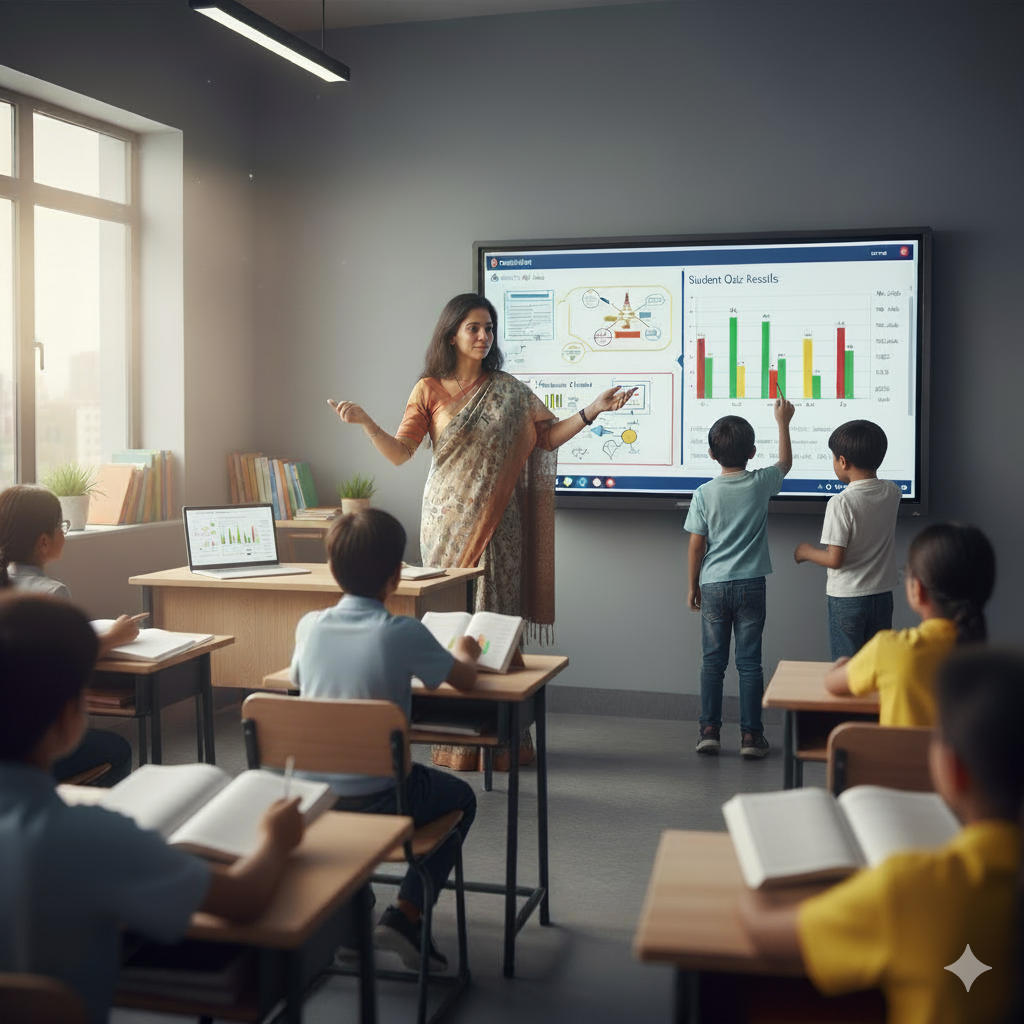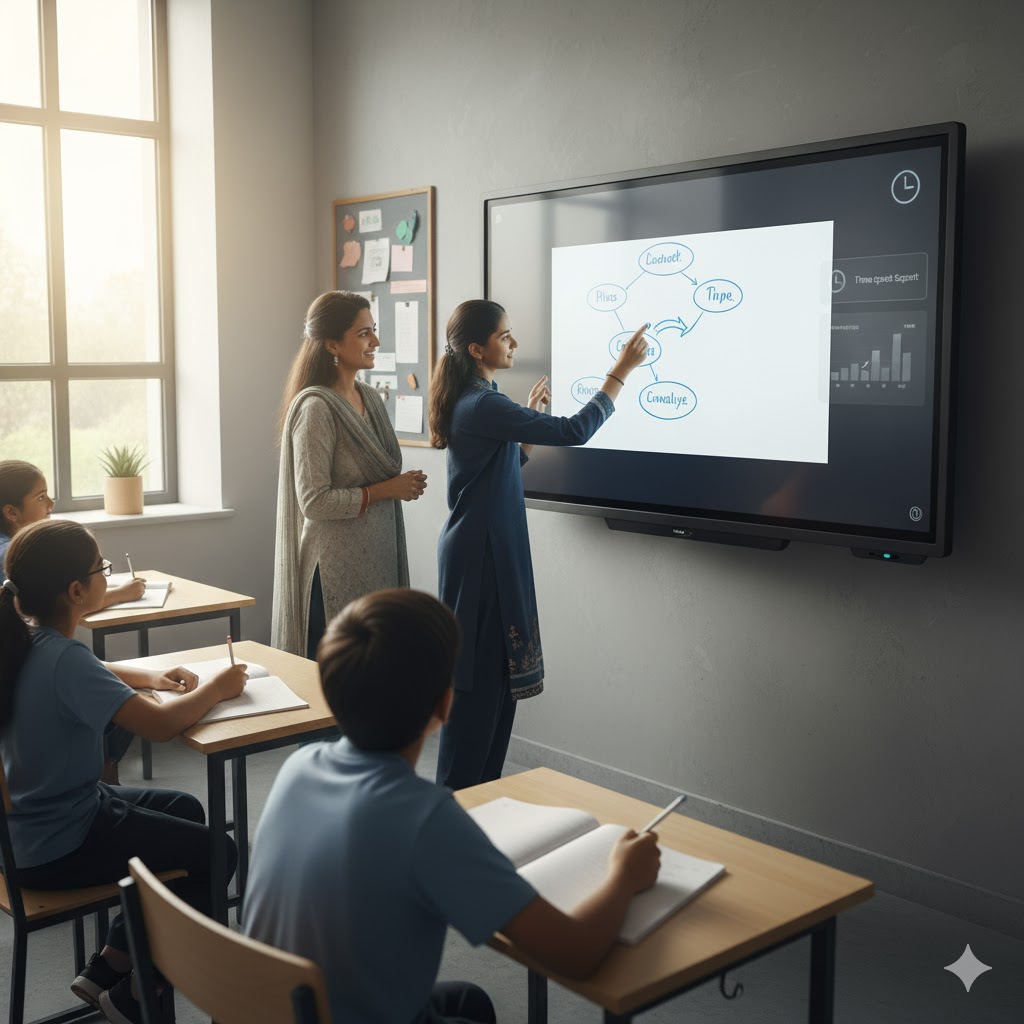Smart Board for Classroom: The New Engine for Data-Driven Instruction

Every dedicated educator makes the best efforts to reach every student and give them personalized attention. But the raw information, such as test scores, attendance sheets, and participation tallies, takes away most of your time. It's a mountain of data that often feels impossible to climb, leaving you dependent on intuition rather than concrete evidence. For K-12 and higher education institutions across India, this lack of timely, actionable insight is the primary roadblock to achieving scalable learning outcomes.
The key isn't to generate more data, but to use the tools already available to generate smarter data. Your smart board for a classroom is, fundamentally, a sophisticated data collection terminal. It's time to stop using it only as a large projector and start treating it as your most powerful tool for data-driven instruction. We're going to dive into the practical, technical ways you can use the interactive display to diagnose learning gaps in real-time.
Data Source 1: The Power of In-Lesson Formative Assessment
Traditional assessment is summative; it measures after the fact. The interactive boards for classrooms allow for immediate, formative assessment integrated seamlessly into the lesson flow.
Strategy: Micro-Quizzes and Polling Analysis
An effective teacher uses the interactive display to push out a quick, two-question poll after introducing a core concept. This is where the technical data analysis begins:
- Immediate Visualization: Don't just look at the percentage correct. Look for patterns in the incorrect answers. If a multiple-choice question has options A, B, C, and D, and 35% of the class chose option B, that's not random confusion. It indicates a specific, shared misconception tied to the distractor (B).
- Pacing Adjustment: If the results show high proficiency (e.g., 90% correct), you have evidence that you can move forward immediately, saving precious class time. If proficiency is low, you must pivot. Use the smart board's annotation tools to literally write over the incorrect answer on the screen and dissect why it's wrong, using the group data as your guide. This agility is what defines a modern digital classroom.
- Bridging Gaps with Instant Feedback: By viewing the data instantly, you ensure rapid remedial learning for the confused set of students, rather than waiting for a test a week later when the memory has faded.
Data Source 2: Analyzing the Digital Ink and Interaction Process

The data captured by the smart board for a classroom goes beyond simple correct/incorrect tallies. It captures the process of learning, which is diagnostic gold.
Strategy: Process Analysis Through Annotation Capture
When students work collaboratively on the interactive boards for classrooms—solving a chemistry equation or sketching a historical timeline—their individual steps and hesitations are recorded by the underlying digital classroom solution.
- Tracking Time-on-Task: Did the group working on the digital canvas spend 80% of their time on Step 1 and rush through Step 4? The saved session allows you to analyze their work pace and resource allocation, identifying procedural weaknesses, not just conceptual ones.
- The Power of Digital Ink: If a student attempts to draw a parabola on the board but consistently starts the curve incorrectly, their digital ink reveals a fundamental spatial or graphical flaw. You can extract that saved portion of the lesson and use it as a focused, individualized resource, contributing to genuine personalized learning.
- Creating a Content Library: These annotated, saved sessions aren't just one-time data points. They become a teacher-created library of "How To" guides. You can tag the recorded content and share it with students who missed the lesson or need revision, thereby improving long-term learning outcomes.
Data Source 3: Consumption and Engagement Metrics
In a truly integrated digital classroom environment, the smart board for a classroom isn't isolated. It's connected to a content management system. This connection generates invaluable consumption data.
Strategy: Leveraging Asynchronous Access Data
Many platforms allow teachers to record and publish their live sessions. How students interact with these recorded lessons outside of class is a powerful data stream.
- Revision Hotspots: Does the system show that 75% of your students repeatedly skip to the 12:45 mark in the recorded session (where you explained a particularly difficult theorem)? That segment is now a confirmed "hotspot" for confusion, prompting you to dedicate extra time to that topic in the next class or refine your original explanation.
- Identifying the At-Risk Student: Which students have never accessed the recorded sessions or supplemental materials? This is a clear, objective data point that signals low engagement and a high risk of falling behind. This data triggers an immediate, targeted outreach call from the teacher. It is an intervention based on data.
- Efficiency for Higher Education: In large lecture halls, this data helps professors know which content requires an online tutorial versus valuable, face-to-face time. You can use the interactive display to review the most frequently accessed material first.
Building the 360-Degree Student Profile
For school and college decision-makers, this data stream, all connected through the smart board for a classroom hub, provides a complete, defensible record of student engagement and progress.
The data points collected are extensive:
- Engagement Metrics: The frequency of their participation in digital polls and collaborative exercises.
- Pace of Learning: How often they access saved lessons for revision (Consumption Data) and what time of day they are most active.
- Skill Gaps: Precise, evidence-based identification of where they need extra support, moving away from subjective observation.
This holistic profile ensures that every conversation with a student, a parent, or an accreditation body is grounded in clear, unbiased data, leading to superior learning outcomes for the institution.
Conclusion: Empowering the Human Teacher
The best education technology doesn't replace the teacher. It empowers them. By automating the heavy lift of data collection and simplifying complex analysis, the integrated smart board for a classroom returns the most valuable resource to the educator: the bandwidth to teach with focus and compassion.
Mastering these strategies allows you to replace delayed reaction with immediate intervention, leading to measurable gains in student proficiency and significantly better learning outcomes. To achieve this level of efficiency, you need a single, unified solution that handles the hardware, software, and AI processing seamlessly, such as the Roombr Digital Classroom.
Frequently Asked Questions
1. How does a smart board for a classroom actually collect data on student learning?
An advanced smart board for a classroom, especially when integrated with a full digital classroom solution like Roombr, logs every interaction. This includes automatically tracking responses from in-lesson polls, quizzes run directly on the interactive display, and saving records of student annotations and contributions during collaborative sessions, ensuring real-time metrics are always available.
2. Is a standard interactive display enough for data-driven teaching?
A standalone interactive display is essentially a screen. For true data-driven instruction, you need an integrated ecosystem. Roombr combines the hardware with powerful AI software for automatic assessment, content capture, and detailed learning data analysis, turning the panel into a complete data hub rather than just a visual aid.
3. How does Roombr Digital Classroom's AI feature help teachers personalize learning?
The Roombr AI feature analyzes student performance data to pinpoint individual struggle points. It then enables teachers to easily create or assign targeted remedial learning materials, like specific recorded video chapters or focused assignments, ensuring students receive personalized support without overwhelming the teacher's workload.
4. What are the key benefits of interactive boards for classrooms for school administrators?
For administrators, interactive boards for classrooms provide verifiable, institution-wide analytics on teaching effectiveness, curriculum coverage, and student progress over time. This centralized data supports strategic planning, simplifies accreditation reporting, and helps demonstrate concrete improvements in overall learning outcomes.
5. Is the technology easy for teachers to adopt in K-12 and higher education settings?
Absolutely. The Roombr Digital Classroom is an all-in-one system, designed to be intuitively simple. By combining the computer, high-quality audio, video, and software into one seamless smart board for a classroom unit, we eliminate technical friction, allowing teachers to literally "walk up and teach" with minimal training.
Explore the technological framework that makes this possible, including the Roombr AI and its all-in-one interactive solution designed specifically for the needs of Indian educators and institutions.
Foziya Abuwala
Share
Step Into the future of
Education with Roombr

















